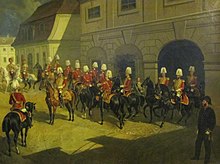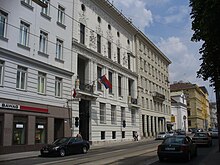Leibgardekaserne

The Leibgardekaserne was located in a house on Rennweg 3–5 in Vienna's 3rd district, Landstrasse , which had been used by various hospitals from 1737 onwards.
In the beginning, the building was used by the Dreifaltigkeitsspital am Rennweg . In 1754 the area was taken over by the Imperial Hospital or Court Hospital (for court servants) and expanded under Empress Maria Theresia . In 1782 Joseph II closed the hospital and quartered the Polish (Galician) Life Guard. In 1803 the oratory of the church was converted into an apartment. After the deployment of the Polish Guard into the Lower Belvedere , the German took from 1838 Arcieren-bodyguard facility. In 1889-1891, the imperial hospital building was largely demolished. The former notary's office of the later mayor Karl Lueger went under.
Imperial Hospital Church
Main article: Guard Church
When the Imperial Hospital moved in , the decision was made to build a hospital church. Architect Nikolaus von Pacassi built the classicist church 1754–1763, which is considered one of his main works. In 1898 the church was rebuilt again. Today it is run by the Polish resourceists and there are fairs in the Polish language.
Successor houses of Otto Wagner
After the barracks were demolished, Otto Wagner built three houses into the vacated space . Otto Wagner built the middle house, Palais Hoyos on Rennweg 3, as his own city palace, which he later sold to the Hoyos family . Within Wagner's work, it is seen as the decisive transition between historicism and Art Nouveau . After the Second World War , the palace was used as the embassy of Yugoslavia . Today the embassy of the Republic of Serbia is located here .
This building is framed by two other buildings with the addresses Rennweg 1 and Rennweg 5. At Rennweg 1, however, the facade decoration was removed after the Second World War, only the rounded corner edge facing Schwarzenbergplatz still reveals Wagner's urban planning intentions.
Rennweg House 5
The house Rennweg 5 actually has its main front towards Auenbruggergasse, which is formed by it and the Guard Church. It is horizontally structured with grooves and floral friezes and on the main front at the entrance portal has recessed mirror fields with rich ornamental decoration. Gustav Mahler lived here from 1898–1909, a memorial plaque reminds of this.
literature
- Dehio manual. The art monuments of Austria: Vienna. II. To IX. and XX. District , Verlag Anton Schroll & Co, Vienna 1993, page 125/126, ISBN 3-7031-0680-8 .
- Felix Czeike : Historical Lexicon Vienna. Volume 1: A – Da. Kremayr & Scheriau, Vienna 1992, ISBN 3-218-00543-4 .
- Bertha Blaschke & Luise Lipschitz: Architecture in Vienna 1850 to 1930. Historicism, Art Nouveau, Objectivity . Springer Verlag, Vienna 2003, page 68/69, ISBN 3-211-83736-1 .
Web links
- The Leibgardekaserne. District Museum Landstrasse, archived from the original on January 6, 2014 ; accessed on January 4, 2018 .
Coordinates: 48 ° 11 ′ 53 " N , 16 ° 22 ′ 41" E
